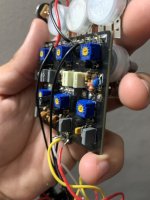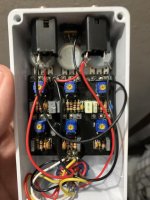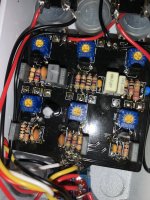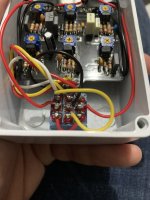Lets start with the basics,
1. All your wires are too long. These need to be shortened, they will act as antenna when the circuit is working.
2. Look up "Tinning Leads" or "Tinning Wire". Prior to soldering wire, the stripped leads need to be tinned. This helps the solder flow better when soldering wires to board or lugs. It also prevents bird caging of the wires when inserting them in the PCB holes.(power gnd to pcb and input jack to pcb wires exhibit this.)
3. When soldering wires to the PCB, get the insulation as close to board as you can with out touching the board, exposed wires are an easy path for a short. Once you do this a few times you will get it down.
4. Even with the rats nest of wire, something looks off about the 3PDT foot switch wiring. Double check this.
5. The enclosure is not grounded. Take a Dremel tool and remove the powder coating on the inside top wall of the enclosure. Now the ring of the input and output jacks will ground the enclosure.
6. There are quite a few cold solder joints on the top side of the PCB. At least one or two on each potentiometer. You need to reflow most of the joints. Touch each joint with the solder iron until the solder re-melts and flows around the joint. If you see the solder pad before you touch the joint, then add the tiniest amount of solder. If there is already a lot of solder on joint, then just reflow it with out adding solder. Do the same on the bottom of the board.
7. CLEAN THE BOARD!! It looks as if you poured a bottle of rosin on the board before you soldered it. If you are using rosin core solder then this is unnecessary and detrimental to the board. Clean the board with a toothbrush and alcohol. Be careful not to use to much alcohol at once. You need to keep it out of the pots and trimmers. With as much rosin as you used, this may take quite a long time to accomplish. When you finished cleaning the board, and if using rosin core flux. Place that bottle of rosin out of your reach! Use it only when you have a stubborn joint or when using de-soldering wick. In the future, clean the board prior to attaching wire and pots. Its much easier then.
One question that needs to be asked, where did the J201's come from? They are TO-92's which are hard to come by. Most people are using the SOT-23 package on an adaptor board because of this.






